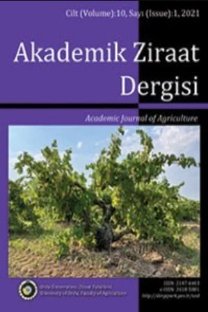Kabuklu Fındık Meyvesinde Derin Öğrenme Tabanlı Kusurlu Meyvelerin Tespiti
Kusur Tespiti, Yapay Zeka, Süreç Yönetimi, Teknoloji ve Yenilik Yönetimi, Karar Destek Sistemleri
Deep Learning-Based Detection of Defective Fruits in Shelled Hazelnut Fruits
Defect Detection, Artificial Intelligence, Process Management, Technology and Innovation Management, Decision Support Systems,
___
- Bayrakdar, S., Çomak, B., Başol, D., & Yücedag, İ. (2015, May). Determination of type and quality of hazelnut using image processing techniques. In 2015 23nd Signal Processing and Communications Applications Conference (SIU) (pp. 616-619). IEEE.
- Boyar, T., & Yıldız, K. (2022). Powdery Mildew Detection in Hazelnut with Deep Learning. Hittite Journal of Science and Engineering, 9(3), 159-166.
- Deng, Z., Sun, H., Zhou, S., Zhao, J., Lei, L., & Zou, H. (2018). Multi-scale object detection in remote sensing imagery with convolutional neural networks. ISPRS journal of photogrammetry and remote sensing, 145, 3-22.
- Giraudo, A., Calvini, R., Orlandi, G., Ulrici, A., Geobaldo, F., & Savorani, F., (2018). Development of an automated method for the identification of defective hazelnuts based on RGB image analysis and colourgrams. Food Control, 94, 233-240. https://doi.org/10.1016/j.foodcont.2018.07.018
- İslam, A., (2021). Fındık. Nobel yayınları, Yayın no: 3893, ISBN: 978-625-417-388-2, Ankara.
- Korkmaz A., & Ağdaş, M.T. (2023), Deep Learning-Based Automatic Helmet Detection System in Construction Site Cameras, Bitlis Eren Üniversitesi Fen Bilimleri Dergisi, 12(3), 773-782, Sep. 2023, doi:10.17798/bitlisfen.1297952
- Korkmaz, A., & Büyükgöze, S. (2019). Sahte web sitelerinin sınıflandırma algoritmaları ile tespit edilmesi. Avrupa Bilim ve Teknoloji Dergisi, 16, 826-833. DOI: 10.31590/ejosat.598036
- Label Sudio (t.y.). Image Labeling Tool. Erişim adresi https://labelstud.io/
- Pallottino, F., Menesatti, P., Costa, C., Paglia, G., De Salvador, F. R., & Lolletti, D. (2010). Image analysis techniques for automated hazelnut peeling determination. Food and Bioprocess Technology, 3, 155-159.
- Ren, S., He, K., Girshick, R., & Sun, J. (2015). Faster r-cnn: Towards real-time object detection with region proposal networks. Advances in neural information processing systems, 28.
- Solak, S. ve Altınışık, U. (2018). Görüntü işleme teknikleri ve kümeleme yöntemleri kullanılarak fındık meyvesinin tespit ve sınıflandırılması. Sakarya Üniversitesi Fen Bilimleri Enstitüsü Dergisi, 22(1),56-65.
- Tan, F. G., Yüksel, A. S. Aydemir, E., Ersoy, M. (2021). Derin öğrenme teknikleri ile nesne tespiti ve takibi üzerine bir inceleme. Avrupa Bilim ve Teknoloji Dergisi, 25,159-171.
- Ünal, Z. & Aktaş, H., (2023). Classification of hazelnut kernels with deep learning. Postharvest Biology and Technology, 197, 1-9. https://doi.org/10.1016/j.foodcont.2018.07.018
- Wu, Y., Kirillov, A., Massa, F., Lo, W.Y., & R. Girshick, (2019), Detectron2, Erişim Adresi: https://github.com/facebookresearch/detectron2.
- Yıldız, T. (2020). Türkiye’de fındık tarımında hasat-harman mekanizasyonu. Tarım Makineleri Bilim Dergisi, 16(1), 12-22.
- ISSN: 2147-6403
- Yayın Aralığı: Yılda 2 Sayı
- Başlangıç: 2012
- Yayıncı: Ordu Üniversitesi Ziraat Fakültesi
Fındıkta (Corylus avellana L.) Aşı Kaynaşmasının Anatomik ve Histolojik Gelişimi
Fındık Atığı Ürünlerinin Buğday Yetiştiriciliğinde Değerlendirilmesi
Selahattin AYGÜN, Damla BENDER ÖZENÇ
Kabuklu Fındık Meyvesinde Derin Öğrenme Tabanlı Kusurlu Meyvelerin Tespiti
Oğuzhan KIVRAK, Mustafa Zahid GÜRBÜZ
‘Kalınkara’ Fındık Çeşidinde Çotanak Dökümü
Ordu-Kumru Yöresi Fındık Bahçelerinin Toprak Verimlilik Durumlarının Belirlenmesi
Azerbaycan’da Yetiştirilen Bazı Fındık Çeşitlerinin Meyve Özellikleri
Binyat İSMAYİLZADA, Selim KARAGÖL, Ali İSLAM
Özkan KİLİN, Melse Su BİLGİLİ, Aslıhan ÇETİNBAŞ GENÇ
Düzce İli Fındık Bahçelerinde Tarımsal Uygulamalar ve Üreticilerin Pestisit Kullanım Durumu
Tuba BATUR, Zübeyde Filiz ARSLAN, Nedim ALTIN
Ali İSLAM, Selim KARAGÖL, Valerio CRISTOFORI, Mercè ROVIRA
Fındık Meyvesi ile Yaprakların Mineral Bileşimleri Arasındaki İlişkiler
